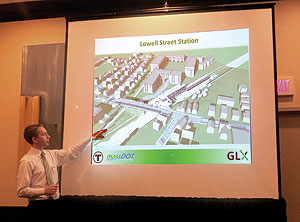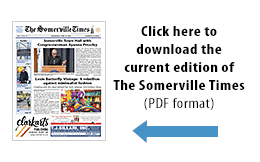
Bryant Associates’ Mark Suscovich presented details to the curious crowd that gathered at the Holiday Inn last week, hoping for a clear vision of what to expect concerning the Community Path and the Green Line Extension. – Photo by Blake Maddux
By Blake Maddux
In the Suffolk Room at the Holiday Inn at 30 Washington Street last Tuesday, Hayes Morrison of the City of Somerville Department of Transportation commenced a presentation of the plans for the Community Path from Lowell Street to Inner Belt Road.
“I am aware that a lot of you are actually here to talk about how we get from Inner Belt over to Cambridge,” Morrison said. “I am just as excited as all of you to talk about that. Unfortunately, for the most part I don’t think that the Green Line team is ready to discuss it, but they will field your questions as best as possible, and so will I.”
Morrison then introduced Mark Suscovich, of the engineering firm Bryant Associates. Shortly after he took the floor, Suscovich asked the more than 80 people in the tightly packed room to “please keep all questions until the end.”
“The purpose is to extend the Minuteman all the way to, towards Cambridge,” Suscovich explained. “The Cedar Street to Lowell Street [portion] is out to bid, and will be constructed in the spring and next summer. The Green Line has committed to the 100% design of the Community Path from Lowell Street to Inner Belt.”
He added, “The connections from Inner Belt to North Point in Cambridge and Boston have not been precluded by the Green Line Extension. But at this time it is not in our scope to design it further.”
Suscovich then presented slides that depicted the plans for the Community Path. He spoke for five-and-a-half minutes with minimal interruptions. At about that point, however, his request that for all questions wait until the end apparently began to slip the minds of those in attendance.
Within a few minutes thereafter, the dam burst completely, allowing thoughtful, informed, and detailed questions form the audience to pour in.
Suscovich and project team members Mary Ainsley (Senior Director of Design & Construction for the GLX), Karen Shaffer (Senior Project Executive for the real estate and construction company Gilbane, Inc.), and Robert Cone (Design Manager and Vice President of HDR Engineering, Inc.) all helped provide answers.
The perpetual stream of questions was not the only indication of the zeal that those in attendance have for the Green Line Extension (GLX) project. Several people were wearing GLX T-shirts or “Friends of the Community Path” stickers. At least one person present mentioned having been the last meeting about the project which, according to Suscovich, was in September 2011.
Suscovich did manage to continue presenting his more than 40 slides, which in turn prompted further queries, several dealing with the safely of the cyclists and pedestrians who would be sharing the path.
The size of the audience increased from the start of the talk onward. After about half an hour, employees of the Holiday Inn began to take down the dividing wall in the room in order to provide space for more chairs.
At one point, Mary Ainsley of the Massachusetts Department of Transportation took the floor to address the issue of expansion of the Community Path into Cambridge. She said, “We have not precluded it to continue down to Brickbottom or to Cambridge from North Point.”
When an attendee asked her to explain why this was not specifically in the works, Ainsley responded, “It’s money. It’s not an easy design, I’ll be very honest with you.”
Mark Suscovich then made a false start in continuing his presentation.
After 10 more minutes of questions and answers, Hayes Morrison stood to say, somewhat impatiently, “What we’re doing right now is observing all of these questions that you have, and we’re kind of aware of all of them, and packaging them up, because at the end of the day, most likely, it will be borne upon the city of Somerville to find out how to design those things and how to pay for those things. It’s great to hear all of this, and we’re garnering all of this feedback and thank you very much for telling us all of these things, but at the same time this team [is] going to push back on you, because they have a scope of work that they’re adhering to.”
The Q&A section continued through at least one more of Mark Suscovich’s attempt to finish with his slides.
With more than an hour of the evening past, Karen Shaffer of Gilbane, Inc. said, “What we’ve heard loud and clear in the two years I’ve been out here is that this is a project that people really want. And I think that we’ve been trying to work the design such that we get something that’s affordable. Some situations are not going to be ideal, but I think we’re trying to come up with something that works and that could possibly get funding.”
Lynn Weissman, founder and co-President – with Alan Moore, who was also present – of Friends of the Community Path, rose five minutes later to jokingly ask, “So, we’re in Q&A now?”
Weissman spoke for several minutes, saying, “The city of Somerville has been enormously supportive in getting the Community Path done. We have a friendly disagreement about how the path should get over those tracks in that area from Inner Belt to Lechmere. We would love the City of Somerville to support our view, of course, partially because that Green Line section will get done in the next five years. It’s important for us to maintain a good relationship with Somerville. We just think this could get done sooner.”
After Weissman finished and another attendee asked a question about the project’s timeline and cost, Karen Shaffer said, “The commitment [from the state] was to make sure that anything that we’re doing on the Green Line is not precluding the path from happening, and that any engineering for the Green Line is taking into account the path. The state did commit to building portions of the path that would be hard to do later.”
She continued, saying, “The path itself, as it exists and what you saw, is not yet funded. There has been a lot of outcry to build that along with the Green Line. There has been no commitment to that yet. The big issue for the state is that they’re still struggling to get all of the funding in place to build the entire Green Line, so committing to build a path when you don’t have all of the money lined up for the Green Line yet is a little bit of a stretch.”
Although it was not perfectly clear if Mr. Suscovich actually finished all of his slides, the meeting did come to an end within the two hours for which it was scheduled.















Reader Comments